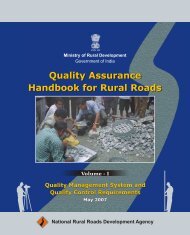Grameen Sampark Final April 0... - pmgsy
Grameen Sampark Final April 0... - pmgsy
Grameen Sampark Final April 0... - pmgsy
Create successful ePaper yourself
Turn your PDF publications into a flip-book with our unique Google optimized e-Paper software.
India mostly consist of granular pavements with thin<br />
bituminous surfacing, in which rutting is considered as<br />
the only mode of failure. This is attributed to the vertical<br />
compressive strain at the top of subgrade layer.<br />
Several highway organizations have developed their<br />
own failure condition and performance criterion for<br />
design of low-volume roads. In this study, the criteria<br />
developed by AASTHO, AustRoads, Asphalt Institute<br />
TRRL, etc. have been discussed.<br />
Performance and Failure Criteria for<br />
Pavement Design<br />
In mechanistic design methods, the limiting values of<br />
stresses and/or strains at which a given degree of distress<br />
will occur are commonly known as the performance<br />
criteria. The rationality of the design procedure can be<br />
judged from the way the corresponding performance<br />
criteria have been developed. Performance criterion is<br />
generally developed considering a failure condition,<br />
which may be any structural or functional failure or<br />
both. Fatigue cracking of bituminous surfacing and<br />
permanent deformation (rutting) along wheel paths,<br />
mainly due to repeated application of traffic loads, have<br />
been identified as the two major modes of structural<br />
failures that need to be addressed in the structural<br />
design of pavements. Some performance criteria also<br />
use roughness as the mode of failure in terms of present<br />
serviceability index (PSI) [1]. The low-volume rural<br />
Pradhan Mantri Gram Sadak Yojana<br />
roads in India mostly consist of granular pavements with<br />
thin bituminous surfacing, in which rutting is<br />
considered as the only mode of failure, which occurs<br />
due to vertical compressive strain at the top of subgrade.<br />
In this paper, the rutting criteria adopted by different<br />
highway organizations for design of low-volume road<br />
pavements have been presented with the objective of<br />
comparing these criteria with that adopted for design of<br />
Indian roads.<br />
Selection of Critical Performance Parameters<br />
Horizontal tensile strain at the bottom fibre of<br />
bituminous bound layer and vertical compressive strain<br />
on top of subgrade have traditionally been taken to be<br />
causative for the two major modes of failures<br />
considered, i.e., fatigue cracking and rutting. Excessive<br />
strains applied repeatedly have been considered to be<br />
the major factors for the development of the two modes<br />
of failures. Figure 1 shows a typical layered flexibile<br />
pavement system subjected to a dual wheel loading<br />
applied at the surface.<br />
Deformation or rutting provides the principal indication<br />
of deterioration in granular pavements with thin<br />
bituminous surfacing. It develops chiefly in the wheel<br />
tracks,and increases with time or more precisely with<br />
the cumulative application of commercial traffic.<br />
Bituminous Surfacing<br />
Granular Base<br />
Granular Sub-base<br />
Subgrade<br />
Figure 1: Critical mechanistic parameters<br />
ε z<br />
ε E t 1,µ 1<br />
E, 2 µ 2<br />
E, 3 µ 3<br />
E, 4 µ 4<br />
<strong>Grameen</strong> <strong>Sampark</strong> 17

















